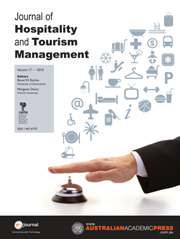Crossref Citations
This article has been cited by the following publications. This list is generated based on data provided by
Crossref.
Dwyer, Larry
2015.
Computable general equilibrium modelling: an important tool for tourism policy analysis.
Tourism and hospitality management,
Vol. 21,
Issue. 2,
p.
111.
Tang, Chengcai
Zhong, Linsheng
Fan, Wenjing
and
Cheng, Shengkui
2015.
Energy consumption and carbon emission for tourism transport in World Heritage Sites: a case of the Wulingyuan area in China.
Natural Resources Forum,
Vol. 39,
Issue. 2,
p.
134.
Dwyer, Larry
Forsyth, Peter
and
Spurr, Raymond
2016.
Tourism economics and policy analysis: Contributions and legacy of the Sustainable Tourism Cooperative Research Centre.
Journal of Hospitality and Tourism Management,
Vol. 26,
Issue. ,
p.
91.
Ponjan, Pathomdanai
and
Thirawat, Nipawan
2016.
Impacts of Thailand’s tourism tax cut: A CGE analysis.
Annals of Tourism Research,
Vol. 61,
Issue. ,
p.
45.
Meng, Sam
and
Pham, Tien
2017.
The impact of the Australian carbon tax on the tourism industry.
Tourism Economics,
Vol. 23,
Issue. 3,
p.
506.
Zhang, Jiekuan
and
Zhang, Yan
2018.
Carbon tax, tourism CO 2 emissions and economic welfare.
Annals of Tourism Research,
Vol. 69,
Issue. ,
p.
18.
Zhou, Dequn
An, Yunfei
Zha, Donglan
Wu, Fei
and
Wang, Qunwei
2019.
Would an increasing block carbon tax be better? A comparative study within the Stackelberg Game framework.
Journal of Environmental Management,
Vol. 235,
Issue. ,
p.
328.
Seier, Maximilian
and
Schebek, Liselotte
2019.
Flexible Stromerzeugung in kommunalen Kläranlagen: Auswirkungen auf Kraftwerkseinsatz, Strombezugskosten und Treibhausgasemissionen.
Zeitschrift für Energiewirtschaft,
Vol. 43,
Issue. 3,
p.
159.
Zhang, Jiekuan
and
Zhang, Yan
2020.
Could the ETS reduce tourism-related CO2 emissions and carbon intensity? A quasi-natural experiment.
Asia Pacific Journal of Tourism Research,
Vol. 25,
Issue. 9,
p.
1029.
Maxim, Maruf Rahman
and
Zander, Kerstin K.
2020.
Green Tax Reform in Australia in the Presence of Improved Environment-Induced Productivity Gain: Does It Offer Sustainable Recovery from a Post-COVID-19 Recession?.
Sustainability,
Vol. 12,
Issue. 16,
p.
6514.
Cao, Fangdong
Zhang, Yan
and
Zhang, Jiekuan
2021.
Carbon tax, economic uncertainty and tourism: A DSGE approach.
Journal of Hospitality and Tourism Management,
Vol. 49,
Issue. ,
p.
494.
Yang, Xiaojie
Zhao, Cenying
Xu, Han
Liu, Keji
and
Zha, Jianping
2021.
Changing the industrial structure of tourism to achieve a low-carbon economy in China: An industrial linkage perspective.
Journal of Hospitality and Tourism Management,
Vol. 48,
Issue. ,
p.
374.
Zhang, Jiekuan
2021.
Impacts of the emissions policies on tourism: An important but neglected aspect of sustainable tourism.
Journal of Hospitality and Tourism Management,
Vol. 47,
Issue. ,
p.
453.
Heffer-Flaata, Hedvig
Voltes-Dorta, Augusto
and
Suau-Sanchez, Pere
2021.
The Impact of Accommodation Taxes on Outbound Travel Demand from the United Kingdom to European Destinations.
Journal of Travel Research,
Vol. 60,
Issue. 4,
p.
749.
Meng, Samuel
Pham, Tien
Dwyer, Larry
and
Grant, Bligh
2021.
Carbon Price Impacts on the Chinese Tourism Industry.
Journal of Travel Research,
Vol. 60,
Issue. 2,
p.
370.
Zha, Jianping
Fan, Rong
Yao, Yao
He, Lamei
and
Meng, Yuanyuan
2021.
Framework for accounting for tourism carbon emissions in China: An industrial linkage perspective.
Tourism Economics,
Vol. 27,
Issue. 7,
p.
1430.
Zhang, Jiekuan
and
Zhang, Yan
2021.
Why does tourism have to confront the emissions trading scheme? Evidence from China.
Tourism Management Perspectives,
Vol. 40,
Issue. ,
p.
100876.
Zhang, Jiekuan
2022.
Tourism economic dynamics under carbon intensity target policy.
Journal of Environmental Planning and Management,
Vol. 65,
Issue. 11,
p.
2145.
Wickramasinghe, Kanchana
and
Naranpanawa, Athula
2022.
Systematic literature review on computable general equilibrium applications in tourism.
Tourism Economics,
Vol. 28,
Issue. 6,
p.
1647.
Usman, Ojonugwa
and
Alola, Andrew Adewale
2023.
How do environmental taxes influence the effect of tourism on environmental performance? Evidence from EU countries.
Current Issues in Tourism,
Vol. 26,
Issue. 24,
p.
4034.




